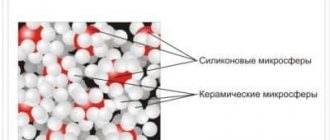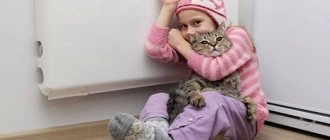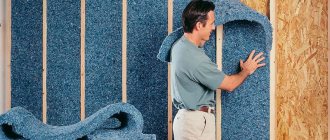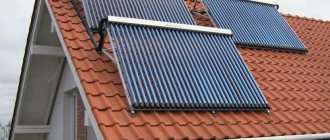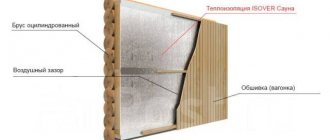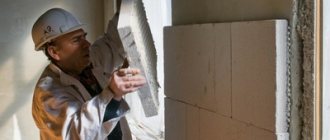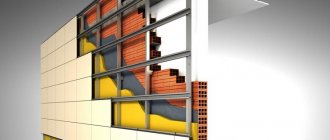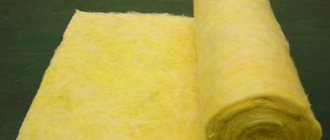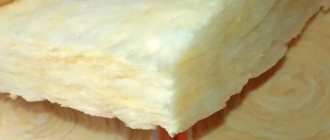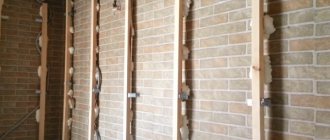Experts are quite ambivalent about the option of insulating a house from the inside of the walls. Most often, this method is considered as an alternative if for some reason it is not possible to insulate the house from the outside. In any case, it is not recommended to insulate a house from the inside without the necessary qualifications. If there is no clear understanding of how to insulate the walls of a house from the inside, then mistakes in choosing insulation and vapor barrier materials are guaranteed to lead to the constant formation of condensation, which will cause the spread of fungus and mold in the walls.
The general principle of work is unchanged - the sheathing and insulation is attached between its joists
Basic principles of internal thermal insulation
The correct choice of thermal conductivity of insulation makes work on internal insulation as effective as creating an external thermal layer, provided that the heat barrier is correctly placed.
Not every heat-insulating material is suitable for insulating a house from the inside. It must meet certain properties to achieve the assigned tasks:
- Low permeability.
- No secretions harmful to human health.
- Waterproof.
- Ability to maintain configuration under mechanical loads.
It is important to know! The vapor permeability of insulating materials should decrease, that is, the insulation must provide more reliable protection for vapor than a wall. This purpose guarantees the free exit of moist air through the thickness of the wall to the outside.
To avoid problems with insulation from the inside, first of all, you need to determine the location of the dew point. Its correct position should be in the wall or insulation, but not at the junction between them.
Changing the location of the dew point
If this happens, then the accumulation of moisture and, as a result, rot, mold and mildew on the surface is inevitable. This situation is possible due to the large thickness of the insulation, since the wall is completely insulated from internal heat.
This also happens as a result of low vapor permeability. Walls made of brick and concrete are especially susceptible to this phenomenon. In this regard, internal thermal insulation in such houses is justified only in non-alternative options.
But in buildings made of timber or logs, such a layer of insulation is quite acceptable; you just need to maintain a gap between the wall and the insulation. Therefore, in order to meet all the requirements for internal insulation, you must first make a frame on the wall from a vertically located beam along the width of the insulation size.
Then a waterproofing film is spread and secured along the wall and insulation material is placed between the slats. It, in turn, is fixed with transverse strips and then a vapor barrier film is stretched on top.
With internal wall insulation, such a “pie” is created
Video description
Insulation instructions in the following video:
Advice from professionals
When carrying out such work, you need to pay attention to the following points:
- Vapor barrier will help if you make a hermetically sealed joint at the seams.
- The thermal insulation layer should not have a high vapor permeability parameter. In the case where this indicator is higher near the wall than that of the insulating material, steam will escape outside.
- To achieve complete adhesion of polystyrene foam to the wall, the beacon method of applying plaster and the method of leveling the glue with a comb are used. This allows air bubbles to pass between the wall and the insulation.
On a note! To prevent moisture from appearing on the walls, a high-quality ventilation system must be installed in the house - hoods and valves on the windows.
Natural ventilation must be calculated no less carefully than forced ventilation Source sovet-ingenera.com
Insulation of walls inside and outside the house - differences
Wall insulation is carried out both inside and outside .
If it is necessary to insulate walls, then, as a rule, one insulation option is chosen: either from the inside of the load-bearing wall or from the outside.
It is also possible to insulate a wall on both sides, but this is not always necessary : insulation options are chosen based on climatic conditions, construction features, and individual preferences.
Indoor insulation is installed on the inside of the building.
The disadvantages of this option are the following:
- the free space of the room decreases;
- the likelihood of dew point formation inside the wall or between the insulation and the wall.
Internal insulation of the walls of a house is good because:
- weather conditions will not affect the work schedule;
- If the building has cladding, it is possible to preserve it unchanged.
IMPORTANT!
When installing internal insulation, it is necessary to install a reliable vapor barrier inside the building.
Insulation of external walls is carried out from the outside of the building. With this type of thermal insulation, the usable area of the structure is preserved; there is no need to install a vapor barrier layer . However, if the cladding of the building has already been completed, it must be dismantled.
Rating of wall insulation
The rating of wall insulation was formed through a practical study of all materials, analysis of the opinions of experts involved in professional construction, and people who used thermal insulation in the construction of their own homes. As a result of the comprehensive work of vyborexperta.ru specialists, it was possible to determine the 12 best insulation materials for walls, optimal for use in various types of buildings. The entire rating is divided into 2 large blocks. The first includes products intended for finishing the external coating of buildings, the second - for interior decoration.
The main attention is paid to the characteristics of materials. The selection includes only products that have all the advantages necessary for comfortable use in construction. During the analysis, the emphasis was placed on how the material manifests itself in real conditions and protects the room from the adverse effects of the climate. The list of main criteria is as follows:
- Sheet thickness;
- Leaf area;
- Areas of application;
- Minimum and maximum operating temperatures;
- Coefficient of thermal conductivity.
Also, when considering the nominees, the price was taken into account, and how it relates to the quality of the materials.
The best plasters
Types of insulation - which is better?
For proper internal insulation of a wooden house, insulation materials are used that, while maintaining thermal insulation properties, do not cause an unpleasant odor over time, are fireproof and environmentally friendly.
The most common options for internal insulation are:
- mineral basalt wool . It is the most popular material for wall insulation. The features of this material are: good thermal insulation properties, high level of sound insulation, fire resistance, strength, high hygroscopicity, due to which it is necessary to install piping from vapor barrier films;
- foam boards . Because the material can release styrene, extruded polystyrene foam is used, which requires a containment system. The material has good thermal insulation, has soundproofing properties, however, it is quite fragile;
- glass wool It has greater thermal conductivity than mineral wool, but the price of the material is significantly lower than basalt slabs. The material crumbles a lot, so it should be laid in protective equipment: crumbs of material are harmful to health. In addition, it is necessary to install enclosing structures;
- isoplat . Insulation, which consists of compressed flax fibers and wood board. An ideal thermal insulation material from the point of view of environmental friendliness, and also durable enough that it does not require the installation of fencing systems;
- polyurethane foam , which is installed by spraying it onto the surface, is installed using special equipment. Modern and quite expensive material.
Comparative characteristics of thermal insulation
The type of insulation should be chosen based on the characteristics of the building, climatic conditions, and the purpose of the building.
Selecting a material based on the type of construction
It is not advisable to insulate frame, wooden, adobe, adobe structures with vapor-tight materials. Otherwise, moisture will begin to accumulate under the insulation, which will lead to damage to wooden structures susceptible to water. Fungus and mold will begin to develop on the frame.
Suitable options for wooden and frame buildings: mineral wool, ecowool, cork. It is better to insulate stone, gas block, concrete, brick and shell rock with vapor-proof insulation materials: penofol, polyurethane foam, extruded polystyrene foam.
Choosing the correct thickness of insulating material will allow you to shift the dew point deeper into the wall without causing condensation to form.
Criterias of choice
In order to choose the most successful insulation option intended for internal wall insulation, you must first pay attention to the following characteristics:
- Resistance to high temperatures and exposure to open fire (fire safety).
- Low thermal conductivity, preventing the outflow of heat from the room.
- Safety (absence of toxic substances and toxic impurities).
- Durability and the ability to retain its original shape for a long time.
- Resistant to moisture and aggressive substances.
The material from which the walls are made and its characteristics also play an important role.
For a panel house, it is recommended to choose the material depending on the future decoration of the walls of the room.
If the walls are planned to be plastered, then it is best to insulate them with extruded polystyrene foam. Feature - the flammability group of EPPS should not exceed G1 .
The choice in favor of expanded polystyrene is also justified by the minimal capture of usable space.
If the walls are sheathed with plasterboard, then they can be insulated with mineral wool and other soft insulation materials, with the obligatory installation of a vapor barrier layer.
It is not recommended to insulate walls in panel houses with polystyrene foam, due to its high flammability and ability to accumulate moisture .
The main task of internal insulation of a house made of foam blocks is to ensure vapor barrier of the thermal insulation material on both sides. (second wall) also required For this purpose, plasterboard or lining is used.
Accordingly, soft cotton insulation or polystyrene foam will not work. It is best to use polyurethane foam, penoplex and polystyrene foam.
A wooden house is made of environmentally friendly material , and the choice of insulation is guided precisely by this characteristic. The best option for insulating wooden walls of a private house is laying ecowool. It is also possible to use polystyrene foam and penoplex, which cannot be said about polystyrene foam.
Expanded polystyrene during operation begins to release carcinogenic substances harmful to humans and animals.
Mineral wool is well suited for insulating an apartment, if the footage allows . You can also use polystyrene foam, provided you first apply a layer of liquid waterproofing to the prepared wall surface.
However, polystyrene foam, like penoplex or foil penofol, is a waterproof material that increases the risk of mold and mildew .
Cork material, warm plaster or fiberboard are excellent for insulating apartment walls. This is only a small part of the commercially available insulation materials, so the choice must be made based on the characteristics of the apartment’s external wall , as well as room finishing options.
The best foam insulation
The material is obtained by foaming a polymer, but differs from the previous group of products in the rating due to its larger cells. This technology is easier to implement, so home insulation is cheaper, but the density is one of the lowest.
Knauf Therm House
Rating: 4.9
The first place in the ranking was taken by a product from a well-known brand, the name of which directly indicates its intended use - home insulation. Suitable for laying in floors along joists, insulating pitched roofs, and laying in wall niches. It is environmentally friendly and does not emit harmful gases into the room during operation. The manufacturer claims a service life of up to 100 years. The product is manufactured in accordance with GOST 15588-2014 and has quality certificates. Unlike extruded types, this one is not attractive to rodents.
The insulation is rated by experts as the lightest - the weight of a 100x60 cm sheet with a thickness of 5 cm is 400 g. This is the best option for finishing the walls of a house if the masonry already puts a large load on the foundation and a minimum mass is required from the insulating layer so as not to cause damage to the foundation . But due to the rigid structure, the craftsmen in the reviews advise insulating the seams with polyurethane foam to eliminate “cold bridges”.
Advantages
- the lowest price in the entire product rating;
- a light weight;
- many options for the cross-section and size of the slabs;
- not afraid of water.
Flaws
- density is only 10 kg/m3;
- burns and emits toxic smoke;
- crumbles during installation;
- You need to cut accurately and additionally insulate the seams with sealant.
Preparing the room for internal insulation
Like any other construction project, internal insulation begins with preparation. At this stage you need to do the following:
- Eliminate weak and defective areas;
- Perform antiseptic surface treatment.
First of all, you need to assess the general condition of the walls, the presence of cracks, chips in the plaster, and weak spots.
It is recommended to eliminate all defects found. And the point here is not so much the quality of insulation, but rather the improvement of the performance characteristics of the walls. Correcting defects in a timely manner will prevent them from aggravating the situation in the future. After all, if the crack spreads further and the plaster falls off, then to fix this problem you will need to dismantle a large section of the insulation and redo everything again. This is not only unpleasant, but also expensive, time-consuming, and labor-intensive. It is imperative to check the walls for existing mold and fungi before insulating them from the inside. Under no circumstances should you carry out further work until the problem has been completely eliminated. If fungal infections are found, we recommend removing the plaster in this area completely - to the base of the wall. Next, you need to treat the area with a special antifungal chemical 2-3 times. There should be no visible marks on the surface after treatment.
For pre-treatment of surfaces in order to destroy existing lesions, we recommend using the following compositions:
- Antiseptic Anti-mold Propitex 1l. A composition that contains active substances to destroy mold on wood, stone, cement and other substrates. Can be used to effectively remove spores, yeast and other types of fungi.
- Dufa mold removal solution. Instant action composition. Due to the inclusion of chlorine, it is characterized by the instant destruction of fungi and mold. Penetrates well into porous wall materials, due to which it is able to remove damage in the structure. When using, it is recommended to thoroughly ventilate the room and use personal protective equipment for hands and respiratory organs.
The next stage is priming the wall with a composition with antiseptic additives. This must be done regardless of whether fungal infections were found or not. In the future, such a composition will effectively prevent the formation of mold under the insulation. You should choose a primer only with special antiseptic properties and a long-lasting effect. For example, suitable:
. Composition for porous surfaces of plasters and concrete. Penetrates deeply into the structure, strengthens, removes dust from the surface and binds small particles. Reduces water absorption and improves strength. Has a long-lasting antiseptic effect with protection against fungi and mold.- Antiseptic Anti-mold Propitex 5 l. This composition has a long-term biocidal effect, due to which it can be used for subsequent insulation.
After the primer composition has completely dried, you can begin subsequent work. The technology for installing insulation will depend directly on the material used for wall insulation. In particular, this can be thermal insulation using polystyrene foam or mineral wool.
How to insulate walls with your own hands?
The algorithm for insulating walls in an apartment from the inside depends on the type of house and the selected insulation. However, the main stages of work remain unchanged in any option:
- Completely prepare a well-dried wall by removing old wallpaper, paint, and remnants of decor or cladding.
- Treat the wall surface with an antiseptic. Let the wall dry.
- Prime. The primer must have deep penetration.
- Plaster the wall if polystyrene foam will be installed.
- Prime the plaster that has dried for several days.
- Instead of plaster, if the walls are insulated with concrete, seal the joints using a special mastic or sealant.
- Install the sheathing if mineral wool is selected.
- Lay insulation or apply it according to individual technology.
- Allow the structure to dry.
- Install a false wall.
Insulating walls from the inside with polystyrene foam: video instructions.
Plaster on insulation
A protective leveling layer on the surface of polystyrene insulation is created using a reinforcing mesh and a special mass designed for this type of material.
Experts recommend purchasing a universal mixture used for gluing reinforcing mesh to insulation boards and subsequent leveling of surfaces from the manufacturers Stolit, Ekomix, Ceresit.
The mesh, which prevents the decorative coating from deforming in the future, is glued with a thin layer of plaster. Then a thin leveling layer of universal mass is applied. The treated surface is left to dry for at least a day.
After drying, the surface can be rubbed. After rubbing, the treated surface is primed . The last stage of work is decorative design.
Insulating a house from the inside with mineral wool
Mineral wool is not an optimal thermal insulation material for internal insulation. There is only one reason for this - cotton wool allows steam to pass through perfectly. Because of this, described at the beginning of the article, the dew point shifts from the inner surface of the wall into the insulation itself. Condensation can accumulate in it, thermal performance deteriorate, and mold and mildew can form. However, it is possible to use mineral wool for internal insulation if all technological nuances are observed.
Choosing mineral wool for internal insulation
Mineral wool should be selected based on criteria such as thickness and environmental friendliness. It is possible to use rolled wool, which is cut to the required length directly during installation. Also, such products are produced in slabs. For internal insulation, 50 mm is the optimal thickness at which good insulation is achieved without significant loss of the usable volume of the room.
Example of suitable types of mineral wool:
- Ecoroll Plate 40. It has a relatively small thickness of 50 mm and does not contain phenol resins. Recommended by the manufacturer for internal insulation, including walls.
- TeploKNAUF For COTTAGE Thermo Plate is a modern insulation material from a well-known manufacturer, the features of which are: low thermal conductivity (0.37 W/m*K) and excellent water-repellent properties due to impregnation of the fibers with a special composition. In addition, this board has a special fiber arrangement structure, due to which sound absorption significantly increases. Thus, this insulating material is recommended for insulating the inside of walls, floors, and attics in houses located in noisy areas.
Basalt wool for internal insulation
Separately, attention should be paid to a type of mineral insulation such as basalt wool. The peculiarity of this heat insulator is not only its excellent thermal insulation properties and environmental friendliness, but also its high fire safety. Basalt fiber is obtained from natural stone. Accordingly, such a material has excellent resistance to open flames.
The fire resistance of basalt wool is an important nuance that must be taken into account when insulating the walls of wooden houses, country houses, and baths. In this case, we especially recommend choosing certified products.
These could be slabs:
- Rockwool Light Butts SCANDIC. Products that are designed specifically for insulating residential buildings, apartments and cottages. It is characterized by compliance with environmental standards (has low resin emissions, safe in residential areas). Flexi technology ensures simple installation with filling of gaps in the frame due to the spring properties of the insulation. The material is biostable - bacteria and mold do not form in it, and it is not a good habitat for insects or rodents.
- Rocklight insulation. Manufacturer TechnoNIKOL recommends using this insulation for internal thermal insulation from inside walls, floors, and attics. The material has low thermal conductivity (0.39-0.41 W/m*K). It is non-flammable, bioresistant, and due to special impregnations, it repels water well without accumulating it inside the structure. At the same time, the compressibility of the slab is 30%, which makes it possible to simplify the process of laying it between the joists and efficiently seal all the cracks and gaps.
Installation of mineral wool indoors
A vapor barrier film must be installed around the perimeter of the wall.- A frame made of wooden blocks is mounted on top of the vapor barrier. It is not recommended to use metal profiles. Metal perfectly transmits heat and will become an artificial bridge of cold
- !!! The metal frame should be used when arranging thermal insulation from the inside of objects with increased fire safety requirements together with basalt wool. These include wooden buildings: baths, saunas, etc. !!!
- The joints between the frame and the vapor barrier are taped with tape, since when fastened to the vapor barrier, a hole from the dowel is formed.
- Cotton wool is installed in the frame and carefully compacted to avoid the formation of any cracks.
- A second layer of vapor barrier is installed on top of the frame. This creates a double vapor barrier between the insulated wall and the room.
- The fastening points and joints of the vapor barrier are taped with aluminum tape.
- The frame is covered with preferred slabs - gypsum plasterboard, chipboard, etc.
If the technology is followed and only if a vapor barrier is installed in the insulation, a good result of internal thermal insulation can be achieved. On our own behalf, we would only like to add that insulating a house or apartment from the inside is, rather, an extreme and necessary measure. It is recommended to use it only if it is impossible to install thermal insulation from the outside. If such an opportunity exists, then we definitely recommend considering its implementation as a priority. We hope that the prepared publication will allow us to avoid mistakes and carry out internal insulation as efficiently as possible.
We insulate the walls from the inside using polystyrene foam
When choosing between mineral wool material and expanded polystyrene, you need to keep one nuance in mind. This insulation has low vapor permeability, so it is not recommended to use it on walls with high vapor permeability (timber, logs, porous concrete).
It will be more effective to use for thermal insulation of brick walls and blocks with low moisture permeability. An adhesive mixture is used to glue this material.
When fixing the insulation, in addition to glue, special nails with heads are used.
Special fasteners with wide caps for insulation
Installation of slabs is carried out sequentially in several stages:
- The surface is being prepared. Cleaned, primed and marked with beacons.
- A rail is fixed at the bottom to support the PPS sheets so that there is no displacement during connection.
- Apply glue to the surface of the wall and the plane of polystyrene foam.
- Apply, align and glue the insulation sheets. It is recommended to do this some time after applying the glue.
- The slabs are additionally secured with nails. They are driven in so that the caps are slightly recessed into the polystyrene foam.
- Then a mesh is applied to the slabs, and the surface is treated with plaster mortar with finishing rubbing. After drying, the panels are ready for further finishing: painting or wallpapering.
On a note! Despite the fact that internal thermal insulation is positioned as an alternative to external insulation in bad weather conditions, insulation of walls inside the house is recommended in the summer when the partitions are heated and in the absence of precipitation.
PIR insulation is a modern analogue of extruded polystyrene foam
PIR insulation appeared on the market relatively recently. Therefore, they need to be considered separately. This heat insulator is a three-layer material consisting of an inner layer of polyisocyanurate foam, covered on both sides with aluminum reflective foil.
In fact, PIR (or polyisocyanurate foam) is a special type of polyurethane with a rigid structure, ultra-low thermal conductivity and increased strength parameters. Due to this, it has successfully proven itself as a heater for internal thermal insulation of any premises, from bedrooms to balconies and loggias.
A special property of this insulation is the additional reflection of heat back into the room due to the foil. Thus, the thermal conductivity coefficient decreases to an unprecedented 0.022 W/m*K, water absorption is only 1% (this is when immersed in water for a day). But the main thing is that the vapor permeability of PIR insulation is reduced to zero due to the same foil coating.
For internal insulation, an excellent solution would be to choose materials such as:
- LOGICPIR universal insulation L 1190x590x50 mm. It has the optimal thickness for medium and large rooms, equipped with an L-edge to prevent the formation of cold bridges.
- Insulation LOGICPIR Balcony L 1185x585x30 mm. It is used on the bottom of small unheated balconies. L-edge present.
- Insulation LOGICPIR Balcony L 1190x590x50 mm. Recommended for insulating a heated balcony, as well as a balcony that is part of a living space.
How PIR boards are installed for internal insulation
The aluminum surface of Pir-plates does not allow high-quality fixation of the insulation using the traditional adhesive method. In this case, the technology with plastic mushroom dowels with plastic nails is used.
The very essence of the technology does not differ from the fastening of polystyrene foam described above. After completing the installation of the last slab, the joints are glued. The gaps between the floor and the slab can be filled with polyurethane foam. Next comes finishing. Instead of dowels, you can use wood sheathing. The beam presses the insulation against the wall, after which the cladding is carried out with panels, lining, gypsum board and other materials. An example of installation can be seen in the photo instructions:
Penoplex is an environmentally friendly material for insulation
This heat insulator is a popular modern insulation material that exceeds foam in its qualities. This granular polystyrene mixture has many advantages:
- moisture resistant;
- fireproof;
- environmentally friendly material;
- neutral to chemical influence;
- ideal sound insulator;
- a light weight.
It showed excellent performance under mechanical loads and at low temperatures.
Production of penoplex - solid slabs before further processing
Which brand of wall insulation is best to choose?
The rating contains products from both well-known manufacturers among builders and from little-known companies. To better navigate brands, you should take time to get to know each of them:
- Penoplex is a Russian company founded in 1998. One of the country's largest producers of polymer materials for decoration and finishing of premises. All procedures for the production of materials are carried out at our own production sites.
- Tsmceramic is an international group of companies. It has become widely known for its innovations in the field of energy saving and the production of protective coatings for all surfaces. The main direction of production is heat-insulating materials that meet advanced standards.
- Isover is part of a French concern with a long history. It is world famous, as it includes some of the largest industrial enterprises on the planet. The production of heat-insulating materials began in 1937.
- Izovol is a domestic manufacturer that appeared relatively recently. The company's products are of high quality, confirmed by international certificates.
- Green Board belongs to Construction Innovations LLC and is the only manufacturer of fiberboard materials in Russia and the CIS. The highlight of the company is the environmental friendliness of the products, achieved by a special manufacturing technology.
- Teploknauf is an international company founded in Germany in 1932. A significant part of the brand’s production enterprises are located in the CIS countries. Many years of development have allowed the organization to become one of the leading ones in the world.
- Ursa occupies a leading position among European manufacturers of building materials. Offers technological solutions for heat and sound insulation. The brand's products are used in all areas due to a unique set of characteristics that make them optimal in various situations.
- Bronya is a Russian company that produces liquid insulation for walls. The products it produces have virtually no analogues. The convenience and efficiency of materials allowed the brand to quickly gain recognition and fame.
- TechnoNikol is a domestic manufacturer of materials for roofing, hydro- and thermal insulation. Founded in 1992. The company's factories are located in Russia, Belarus, and European countries. One of the five largest European manufacturers of insulating materials.
- Izospan is a pioneer in the production of vapor and moisture protective materials. The company's products have been manufactured since 2001. During its existence, the company has become one of the most famous in the CIS. The products are manufactured at our own production base: all stages are controlled by company specialists, which ensures high quality materials.
- ShelterEcoStroy - produces thermal insulation without the use of carcinogens. This is the first Russian brand to produce such products. Thanks to ease of installation and ease of use, the company's products quickly became popular in the CIS countries.
- Eurobloc is a Russian company founded in 1995. The brand’s products are constantly evolving: specialists make materials not only better quality, but also more convenient to use. The emphasis is on the functionality of the insulation, which is constantly being expanded.
Stages of work
First of all, before insulating the walls of a house internally, it is important to know that the dew point will change - the place where moist air turns into condensation.
Consequently, if you choose the wrong material or its thickness, then such insulation can worsen the condition of the walls: mold, mildew, or destruction of the partition will appear.
It is important! In order to avoid irreparable mistakes, it is better to entrust all calculations for choosing insulation, as well as installation work, to specialists from a trusted construction company.
Before starting work on wall insulation, certain rules must be followed:
- Remove old coatings to the base of the surface, clean, remove possible formations of mold or mildew.
- Treat the wall with an antiseptic and primer solution. At the same time, give each coating a chance to dry.
- When using polystyrene foam, plaster the surfaces with the placement of beacons, which will allow for a more even plane. Allow to dry for at least two days.
- Laying the material.
- Finishing the wall.
Preparing the sheathing and installing it
For the sheathing of walls inside a wooden dacha, wooden materials are used. Metal lathing is installed when the wall is covered with moisture-resistant plasterboard.
The installation of sheathing includes a number of preparatory works in the following order:
- apply markings for installation of the sheathing. The width of the sheathing is selected based on the width of the insulation minus 2-5 millimeters . The insulation should stand up against the sheathing;
- preparation of corner posts . Necessary for creating an even wall angle. The height of the beam 50x100 mm should be equal to the height of the room. The smaller beam 50x50 mm is fastened with self-tapping screws to the edge of the larger beam, forming a right angle;
- making corner posts for all corners of the room;
- preparation of vertical boards for sheathing: boards are cut according to the height of the room in quantities corresponding to the pitch, 2 - 5 cm less than the insulation board.
Installation of the sheathing begins from the corners : using self-tapping screws, the corner posts are installed in their places, their vertical position is checked with a level. Next, from the corners to the center, the remaining sheathing boards are attached along the entire perimeter.
The next step is to install strips around the wall openings.
CAREFULLY!
All wooden elements of the sheathing must be treated with solutions against mold, mildew, and moisture.
After installing the lathing, a layer of heat-insulating material is laid.
Installation of sheathing
